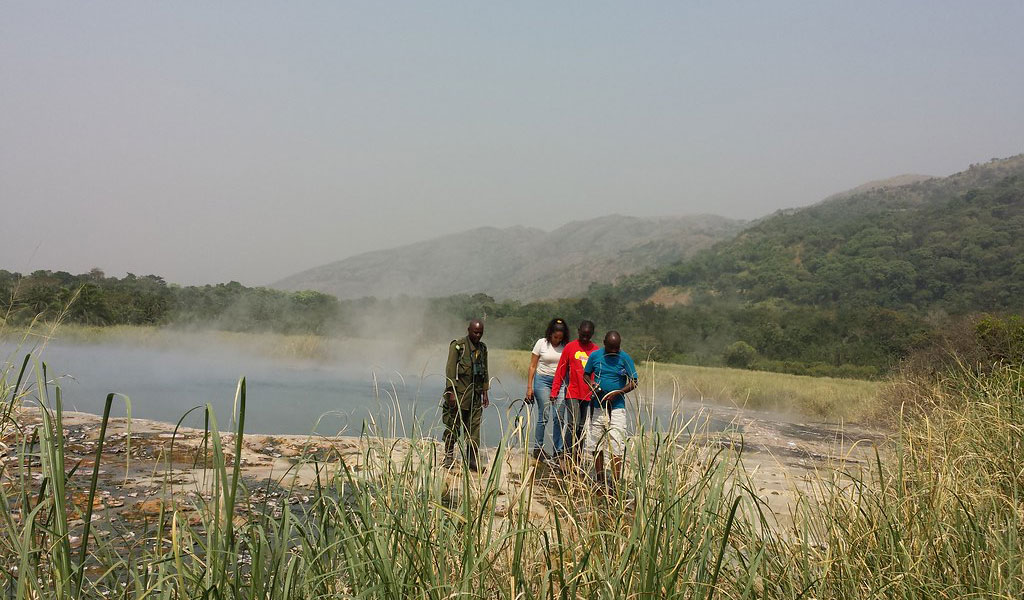
Toro-Semuliki National Park
Toro-Semuliki Wildlife Reserve is located in western Uganda, spanning 542 km² within Ntoroko and Kabarole districts. Established as a game reserve in 1926, it was among the first protected areas in Uganda, initially created to safeguard the large populations of Uganda Kobs.
The park sits in a dramatic rift valley between the Rwenzori Mountains, the Kijura Escarpment, and Lake Albert. The area features open acacia-combretum woodlands, grassy savannahs, patches of borassus palm forests, and riparian woodlands along the main watercourses. Extensive swamps near Lake Albert also add to the park’s varied landscape. Despite its relatively low altitude of about 700 meters above sea level, the park offers stunning views on clear days, including the rift valley escarpment, the 2,500-meter-high Congolese Blue Mountains, and the glacial peaks of the Rwenzori Mountains.
Local Communities
Around Toro-Semuliki Wildlife Reserve, there are four main communities:
Karugutu-Kyabandara Community:
Located south of the reserve, about 18 km from Fort Portal, this area is inhabited by the Bakonjo people, who are traditional farmers. They grow crops like maize, cassava, beans, soya beans, rice, and bananas, which are sold in local markets such as Rwebisengo and Ntoroko.
Rwebisengo Community:
Situated on the western and northwestern edges of the reserve in the Semliki Flats, this community is primarily composed of the Batuku (Batoro-Bahuma) people. They are mostly pastoralists and are thought to be descendants of the Abarusula, who were once the royal army of King Kabalega of Bunyoro-Kitara Kingdom.
Ntoroko Fishing Community:
This community is located at the southeastern tip of Lake Albert between the Wasa and Muzizi rivers. It has been designated a Wildlife Sanctuary to protect wildlife in this area. The community relies mainly on fishing.
Kasesenge-Kyakabaseke Community:
Situated on the eastern escarpment of the rift valley, this community is mainly comprised of Bakiga migrants who moved here in the 1960s to work in tea estates. With the decline in tea prices, they have turned to crop cultivation, growing beans, groundnuts, maize, and bananas.
Activities & Attractions in Toro-Semuliki Wildlife Reserve
Primate Walk:
This 3 to 4-hour walk near Semliki Safari Lodge is guided by experienced rangers. You may encounter chimpanzees, Red-tailed monkeys, Vervet monkeys, Black and white colobus monkeys, baboons, and various antelopes like Waterbucks and Uganda Kobs. You might also see elephants and, with some luck, leopards and bush babies.
Game Drives:
The park offers game drives on three tracks through the savannah grasslands. You can see elephants (both savannah and forest types), buffaloes, waterbucks, warthogs, and Uganda Kobs. At night, you might spot nocturnal animals like the white-tailed mongoose.
Nature Walk:
This 3-hour walk explores different habitats from savannah woodlands to riverine forests. You may see Ground Hornbills, warthogs, Uganda Kobs, baboons, and various monkeys.

How to get to Toro-Semuliki Wildlife Reserve
Kampala Fort Portal via Mubende is 290 km and Kampala – Fort Portal via Masaka-Mbarara-Kasese is about 465 km. Follow the route to Semuliki National Park from Fort Portal for the first 28 km before turning right at Karugutu trading centre. The reserve boundary is 3km further on and the turn off to Semliki Safari Lodge is 26km further on just beyond the bridge over the river wasa. Branch to the right 3km to the Lodge. Lake Albert is further on 25km ahead at Ntoroko fishing village where UWA manages bandas, a campsite and a canteen.
There is an airfield managed by UWA so visitors can charter planes and land at Semliki Safari Lodge where the air field is situated.